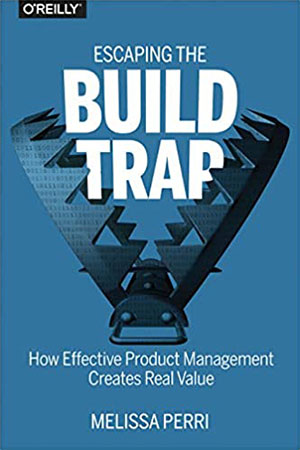What Is the Build Trap?
Early in her book Escaping the Build Trap: How Effective Product Management Creates Real Value, Melissa Perri defines the build trap, which describes the dysfunction that we see in many organizations and contributes to poor user experiences. Essentially, organizations get caught in the build trap when they prioritize outputs over outcomes. These organizations value activity over quality. This phenomenon leads to the production of wasteful features that nobody wants and products that deliver little to no value.
I’ve seen this myself in organizations who encourage their employees to establish goals for themselves, against which the organization evaluates them annually. While goals are a good thing, when people define product-development goals that do not align with the organization’s strategy, this leads to waste and distracts other colleagues from more valuable activities.
As an example, I recall a time when an employee in another part of the organization had launched a blog to promote industrial equipment. As part of the governance team who would have to approve the project, I had several questions: What were the key performance indicators (KPIs)? What was the expected outcome? In the organization, other blogs had seen extremely low user engagement. What would be different about this blog? Finally, we knew that our customers had clearly identified difficulty finding product information as a key source of frustration. How would adding a new blog site with marketing content improve the customer experience?
“But this is my goal for the year! I have to get it done!” said this employee. “I know it’s the week before Thanksgiving, but can’t you just approve it? My boss, the VP of … is going to be upset if this doesn’t launch. This would tank my performance review, and it would all be your fault!”
So it goes with all organizations that go through the motions of setting goals without actually considering the value they would deliver to the customer. Often, teams produce customer-facing user experiences with no real consideration of value exchange. These projects deliver no value and distract coworkers from supporting more valuable user experiences. Plus, the organization bears the costs of developing and maintaining products that they’ve created just for the sake of creating something—anything.
Perri clarifies Product Management’s role by advocating for a strategy that focuses more on outcomes than output. Too often in corporate cultures, we value outputs rather than actual results that deliver real value—not only to shareholders, but to customers. In the context of Escaping the Build Trap, a product is essentially any user experience that a customer would pay for—whether a physical product, virtual product, or service.
 As organizations become more customer obsessed or user centered, we are seeing greater specialization in the delivery of user experiences. We are also experiencing significant changes in how organizations are delivering user experiences. A role that has recently risen in importance and shares some overlap with User Experience is that of Product Management. Specialization and modern forms of project management are encouraging these changes.
As organizations become more customer obsessed or user centered, we are seeing greater specialization in the delivery of user experiences. We are also experiencing significant changes in how organizations are delivering user experiences. A role that has recently risen in importance and shares some overlap with User Experience is that of Product Management. Specialization and modern forms of project management are encouraging these changes.